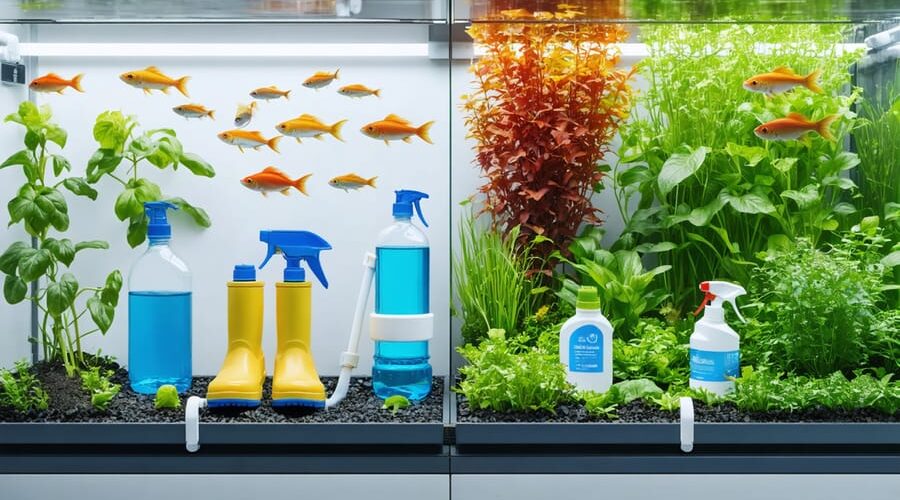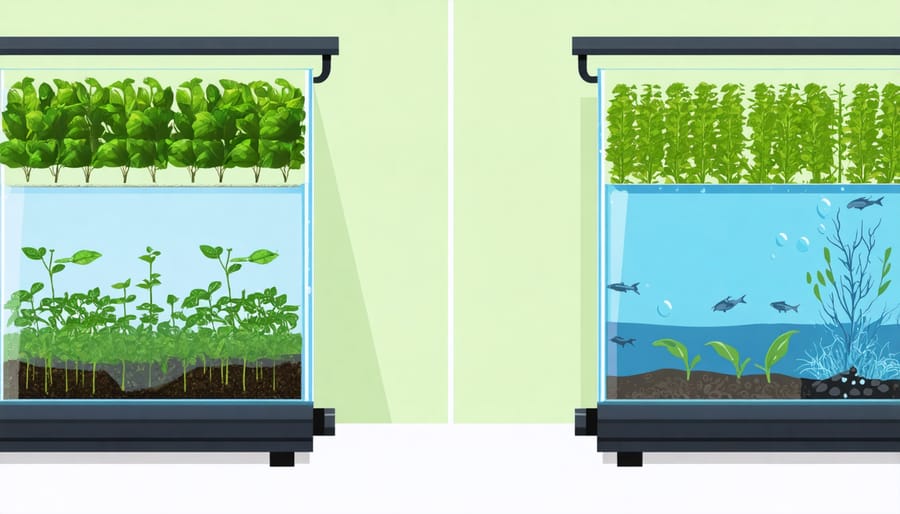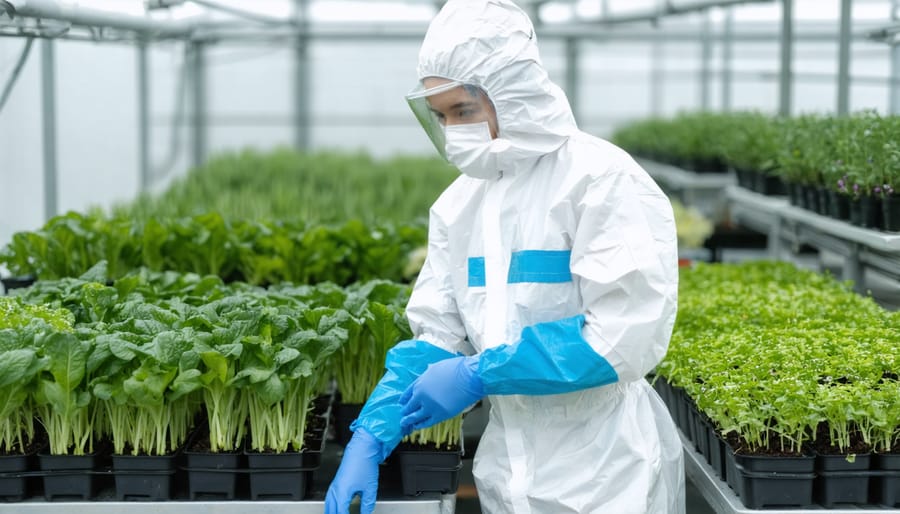
Protect Your Aquaponics System: Essential Biosecurity Steps That Actually Work
Protect your aquaponics setup from disease outbreaks and contamination with robust biosecurity measures. Install foot baths containing approved disinfectants at all entry points to prevent pathogen transfer. Quarantine new fish and plants for at least two weeks in separate holding tanks before introducing them to your main system. Implement a regular cleaning schedule for all equipment, including nets, testing tools, and filtration components using food-safe sanitizers. Monitor water quality parameters daily and maintain detailed records of any changes or unusual observations to quickly identify potential biosecurity threats.
These fundamental protective measures form the foundation of a healthy, thriving aquaponics system that produces safe, sustainable food. While setting up these protocols might seem overwhelming at first, they’re essential investments that prevent costly system crashes and protect both your fish and plants from devastating diseases.
Why Biosecurity Matters in Your Aquaponics Setup

Common Disease Threats
In aquaponics systems, several common diseases can threaten your fish and plants if proper biosecurity isn’t maintained. Fish are particularly vulnerable to bacterial infections like columnaris and aeromonas, which can spread quickly in warm water conditions. These appear as fuzzy patches on fish or red sores that can be fatal if left untreated.
Root rot is a frequent concern for plants, especially in systems with poor oxygen circulation or improper water temperature. Fungal infections can also affect both fish and plants, particularly in humid environments or when organic matter accumulates in the system.
Parasitic infections, such as ich (white spot disease) in fish, are another common threat. These tiny parasites appear as white dots on fish and can quickly multiply if not addressed. Plant pests like aphids and spider mites can also infiltrate your system, particularly in greenhouse setups.
Prevention is always better than treatment. Regular monitoring of water parameters, maintaining proper temperature ranges, and ensuring good system hygiene are your best defenses against these common threats.
Economic Impact of Poor Biosecurity
Poor biosecurity practices can lead to devastating financial losses in aquaponic systems, affecting both small hobbyists and commercial operations. When diseases or invasive species breach a system, entire crops and fish populations can be wiped out within days, resulting in thousands of dollars in immediate losses. Many pond owners have learned this lesson the hard way, losing entire koi collections worth tens of thousands of dollars to preventable diseases.
Beyond immediate losses, the long-term economic impact can be even more severe. Treating contaminated systems requires expensive chemicals and medications, while completely sanitizing an infected system can take weeks or months, during which no production is possible. Some pathogens can persist in equipment and require complete system replacement.
The ripple effects extend to business reputation and customer trust. For commercial growers, a biosecurity breach can lead to lost contracts and damaged relationships with buyers. Recovery often requires significant investment in new equipment, stock, and enhanced security measures. The old saying “prevention is better than cure” couldn’t be more true when it comes to biosecurity – investing in proper measures upfront is far more cost-effective than dealing with the aftermath of a breach.
Essential Entry Point Controls
Personnel Access Protocols
Maintaining proper personnel access protocols is crucial for protecting your aquaponics system from contamination. Start by establishing a clear “clean zone” around your growing area and requiring anyone who enters to follow basic hygiene practices.
Before entering the system area, all visitors and workers should wash their hands thoroughly with soap and water. Keep a sanitizing station near the entrance with hand sanitizer, disposable gloves, and footbaths filled with a mild disinfectant solution. Everyone should step through these footbaths to prevent bringing in harmful organisms from outside.
Consider implementing a sign-in log to track who enters your system and when. This helps monitor access and can be invaluable if you need to trace any issues back to their source. It’s also wise to limit access to essential personnel only – the fewer people interacting with your system, the lower the contamination risk.
For regular maintenance work, wear clean clothes and dedicated footwear that’s only used in your aquaponics area. If you’ve visited other aquaculture facilities, wait at least 24 hours before entering your own system to reduce cross-contamination risks.
Remember to brief all visitors on your biosecurity protocols before they enter. A simple printed checklist near the entrance can serve as a helpful reminder of the steps they need to follow. These measures might seem strict, but they’re essential for maintaining a healthy, productive system.

Equipment Sanitization
Keeping your aquaponics equipment clean is crucial for maintaining a healthy system. Start by creating a regular cleaning schedule for all your tools, nets, buckets, and monitoring equipment. Before each use, thoroughly clean items with food-grade hydrogen peroxide or a mild bleach solution (1 part bleach to 10 parts water).
After cleaning, rinse all equipment thoroughly with clean water to remove any cleaning solution residue. This step is essential as cleaning chemicals can harm your fish and plants. Allow equipment to air dry completely before storage or next use, as moisture can harbor harmful bacteria.
For larger equipment like filters and pumps, establish a monthly deep-cleaning routine. Disassemble these components carefully, clean each part individually, and inspect for wear and tear. Pay special attention to areas where organic matter tends to accumulate, as these spots can become breeding grounds for pathogens.
Store clean equipment in a dedicated area away from potential contaminants. Consider using UV sterilization for smaller tools or implementing a sanitization station near your system. Keep a cleaning log to track when equipment was last sanitized and maintain consistency in your cleaning protocols.
Remember to wear clean gloves when handling equipment and avoid cross-contamination between different system areas. This simple practice can prevent the spread of potential problems throughout your aquaponics setup.
Water Quality Management
Filtration Systems
Filtration systems play a crucial role in maintaining biosecurity in aquaponics setups. These systems work together to remove harmful substances and support beneficial bacteria growth.
Mechanical filters are your first line of defense, catching solid waste and debris before they can break down and compromise water quality. Common types include screen filters, settling tanks, and drum filters, each suited to different system sizes and needs.
Biological filtration happens in media beds or dedicated biofilters where bacteria convert harmful ammonia into safer compounds. These filters can be as simple as expanded clay pebbles or as sophisticated as moving bed biofilm reactors (MBBR).
UV sterilizers offer additional protection by neutralizing harmful pathogens and algae spores. While not essential for all systems, they’re particularly valuable in sensitive setups or when dealing with disease outbreaks.
Regular maintenance of these filters is crucial – clean mechanical filters weekly, monitor biological filter performance, and replace UV bulbs annually. Remember, a well-maintained filtration system is your best insurance against biosecurity threats.
Water Testing Protocols
Regular water testing is a cornerstone of effective biosecurity in aquaponic systems. Following proper water testing procedures helps you catch potential issues before they become serious problems. Test your water at least twice a week, focusing on key parameters like pH, ammonia, nitrites, and nitrates.
Create a testing schedule and stick to it – consistency is key! Keep a logbook to track your results, making it easier to spot trends and changes over time. A simple spreadsheet or notebook works great for this purpose. Make sure to test at the same time each day for the most accurate comparisons.
Store your testing supplies in a clean, dry area away from direct sunlight and extreme temperatures. Replace reagents and test strips according to manufacturer recommendations – using expired materials can give you false readings. Always clean your testing equipment thoroughly after use to prevent cross-contamination.
Remember to test water from different points in your system, not just one location. This gives you a more complete picture of your water quality and helps identify potential problems areas. If you notice any sudden changes in your readings, increase testing frequency and investigate the cause immediately.
Fish Health Monitoring
Quarantine Procedures
Setting up a proper quarantine area is like creating a safe zone for your new aquatic arrivals. Start by designating a separate tank or container away from your main system. This quarantine space should include basic filtration, appropriate heating, and adequate aeration to keep your new additions comfortable.
New fish or plants should stay in quarantine for at least 2-4 weeks. During this time, observe them daily for any signs of disease, unusual behavior, or stress. Keep the quarantine tank simple with minimal decoration – this makes it easier to monitor your stock and perform necessary treatments if needed.
Maintain separate equipment for your quarantine area, including nets, buckets, and testing kits. This prevents cross-contamination between your main system and quarantine setup. When handling quarantined specimens, always work with them last after tending to your main system, and wash your hands thoroughly between tasks.
Remember that while quarantine might seem like an extra hassle, it’s much easier than dealing with a disease outbreak in your main system. Think of it as an insurance policy for your aquatic family’s health.

Disease Prevention
Preventing fish diseases is much easier than treating them, and it starts with smart, proactive measures. Begin by quarantining any new fish for at least two weeks before introducing them to your main system. During this time, observe them carefully for signs of illness or unusual behavior.
Maintain optimal water quality by regularly testing parameters like ammonia, nitrites, and pH. Clean your filters according to schedule, but avoid over-cleaning as this can disrupt beneficial bacteria. Consider installing UV sterilizers to control harmful pathogens in the water.
Feed your fish high-quality food appropriate for their species, and remove uneaten food promptly to prevent water contamination. Keep detailed records of water parameters, fish behavior, and any health issues – this helps spot patterns and potential problems early.
Develop a regular health monitoring routine, checking your fish daily for signs of stress or disease. Look for changes in behavior, appetite, or appearance. Having a basic fish health kit on hand, including essential medications and treatments, allows you to respond quickly if issues arise.
Remember, stress makes fish more susceptible to disease, so maintain stable water conditions and avoid unnecessary disturbances to their environment.
Plant Protection Strategies
Pest Management
Natural pest control methods play a vital role in maintaining biosecurity without harming your system’s beneficial organisms. Start by introducing companion plants like marigolds, lavender, and mint around your growing area to naturally repel unwanted insects. Physical barriers such as fine mesh screens and sticky traps can effectively control flying pests while keeping your system chemical-free.
Beneficial insects are your allies in pest management. Introduce ladybugs and praying mantises to control aphids and other harmful insects. For rodent control, ensure proper sealing of entry points and maintain a clean environment around your system. Consider using ultrasonic repellents as a humane deterrent.
Regular monitoring is crucial. Inspect your plants daily for signs of pest infestation and remove affected leaves promptly. Maintain optimal growing conditions with proper spacing between plants and adequate air circulation to prevent fungal issues. Remember, a healthy system naturally resists pest problems, making prevention your best defense.
Disease Prevention in Plants
Protecting your plants from diseases starts with good hygiene practices and preventive measures. Regular monitoring of plant health helps catch issues early, while proper spacing between plants ensures good air circulation and reduces disease spread. Always use clean, sterilized tools when handling plants, and avoid working with them when they’re wet to prevent fungal growth.
Implementing a quarantine period for new plants is essential before introducing them to your system. This practice allows you to observe any potential disease symptoms without risking your existing crops. Keep your growing area clean by removing dead leaves and plant debris regularly, as these can harbor pathogens.
Consider using natural disease-resistant plant varieties and maintaining optimal growing conditions, including proper temperature and humidity levels. If you notice any diseased plants, remove them immediately to prevent spread to healthy specimens. A preventive approach to plant health will save you time and resources in the long run.
Maintaining proper biosecurity measures isn’t just a one-time task – it’s an ongoing commitment to protecting your aquatic system and its inhabitants. By following the guidelines we’ve discussed, you’re taking essential steps to prevent disease outbreaks, control pest populations, and ensure the overall health of your water garden or pond.
Remember to regularly inspect your quarantine procedures, update your visitor protocols, and maintain detailed records of any health issues or treatments. Make it a habit to clean and sanitize your equipment after each use, and don’t forget to periodically review and update your emergency response plan.
Stay vigilant for any signs of trouble, such as unusual fish behavior or sudden plant die-offs. Early detection and swift action are your best allies in maintaining a thriving aquatic environment. Consider setting up a monthly maintenance schedule to help you stay on top of these important tasks.
While these measures might seem overwhelming at first, they’ll soon become second nature. The time and effort you invest in biosecurity will pay off tremendously in the long run, saving you from potentially costly and heartbreaking problems down the line.
Keep learning, stay informed about new best practices, and don’t hesitate to reach out to other enthusiasts or experts when you need advice. Your dedication to biosecurity is what keeps your aquatic paradise healthy and beautiful for years to come.
